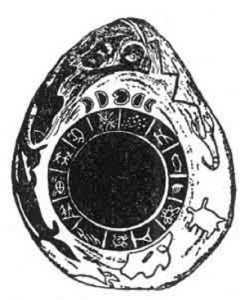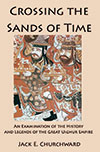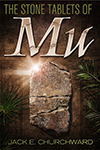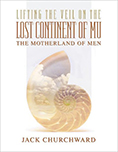As we continue the pursuit of the background of the Mound Builder’s Calendar Stone featured in the 1932 book, Sacred Symbols of Mu, on page 230, perhaps it is best to show what James’ wrote about the stone:

From Sacred Symbols of Mu
A Mound Builder’s Calendar Stone Found in the Ouachita River, Hot Springs, Arkansas
From Col. J. R. Fordyce, Little Rock, Arkansas
A MOUND BUILDER’S CALENDAR STONE.–
Dimensions. The stone is pear shaped. Length about 16 inches, and about 13 inches across at its widest part. “It is a sandstone bowlder such as found in shale near Hot Springs. It weighs 22½ pounds.”
Description. In the center is a slightly raised ring 7¼ inches in diameter. This ring is divided into thirteen equal divisions. On each division is inscribed a figure or a glyph. Superimposed on this circle is another which is much higher. This, I presume to be meant for a picture of the Sun, as the symbol of the Deity. Above this main figure is engraved a caption, the Moon in its various phases during a calendar month. This tells us the meaning of what is below, namely: the circle with the thirteen divisions represents thirteen calendar months, making one year. The thirteen months, forming a circle, tell us that the year is completed, the beginning and the end. Over the caption is shown the All Seeing Eye looking down from heaven above. This is an ancient symbol dating back to the earliest writings, and universally found. Outside of the calendar proper, to the edge of the stone, various animals are shown, including Man.
The Calendar Glyphs.
1. This is too indistinct to say positively what is meant or represented. However, it appears to be a bird with wings outspread. If this is correct, then it probably would be the American Indian Thunder Bird.
2. This seems to portray the Maya month of Zac, the white month, when snow covers the ground with a white blanket.
3. This is a new symbol to me. I do not know its meaning.
4. This is a fish which is symbolically heading upstream, denoting that during this month fish are most plentiful, the time when they make their spring run up to their spawning beds.
5. This glyph is one of the letters in Mu’s alphabet. It has an esoteric meaning.
6. This is a picture of the Sacred Lotus flower, Mu’s floral symbol. The lotus was the most beloved and revered of all Mu’s symbols. The Egyptians always ref erred to Mu as the Lotus.
7. Without this is a line drawing of the head of the Mound Builders’ conventional serpent. I do not know what it is. Among the etchings at the Pipestone Quarry, Minnesota, there are some that are almost identically like it. The Pipestone are without question the heads of the Serpent.
8. This is a sacred symbol common in Oriental countries. Once, and only once, before have I found it in America. That was among the Mound Builders’ remains taken from one of their burial grounds. It is one of those ancient religious symbols whose meaning was lost when the Brahmins persecuted and drove their teachers, the Naacals, out of India into the snowcapped ranges of the Himalayas about 2000 to 2500 B. C. The meaning of the symbol is expressed in four words of the ancient tongue. These words were used before the commencement of a supplication, or prayers. They are being repeated to this day but the priesthood does not know their meaning. The meaning of AUM was forgotten about the same date. So far in months 6 and 8 we find a direct connection between the people who made this calendar stone and the Mound Builders, Mu and the Orient.
9. This glyph is new to me. It appears to picture ripe grain being cut and harvested. The time on this stone is given about August or September. It would thus correspond with harvest time when grain is reaped and stored.
10. This symbol is frequently found in ancient writings. It pictures the fall of the year when trees and shrubs shed their leaves, leaving the branches bare and leafless.
11. This is one of the most conclusive symbols on this stone and directly connects the makers of this stone calendar with the Mound Builders, the Polynesians, and therefore, Mu, as their ancestors came from the Motherland. The symbol is the Grey and Black Pointed Spider, which is discussed later in this chapter. I have received information that similar spiders have been found among the treasures recovered by Schliemann in ancient Troy, Asia Minor. These, however, I have not seen.
12. This symbol is questionable. Is it the outline of a deer?
13. This is certainly an outline drawing of a bison. It is now the last month in the year, the head of this buffalo is pointing in. Is this the time of the year when food has become scarce further north and he is now working in to the south where conditions for the time being suit him better? I think so. The same question applies to the 12th, the deer.
Comments. There are various animals shown on the outer side of the stone. These I have not taken into account although two are very prominent in ancient picture writings and in Indian legends.
It must be apparent that the designers of this Calendar Stone were acquainted with the Cosmic Forces and the Cosmic Sciences as taught during the First Great Civilization. Therefore, America at one time was enjoying the highest civilization the earth has ever known.
Sacred Symbols of Mu, page 230-234
Next we’ll look at what other information found on the internet says about the stone.
Have a great day.









 RSS - Posts
RSS - Posts